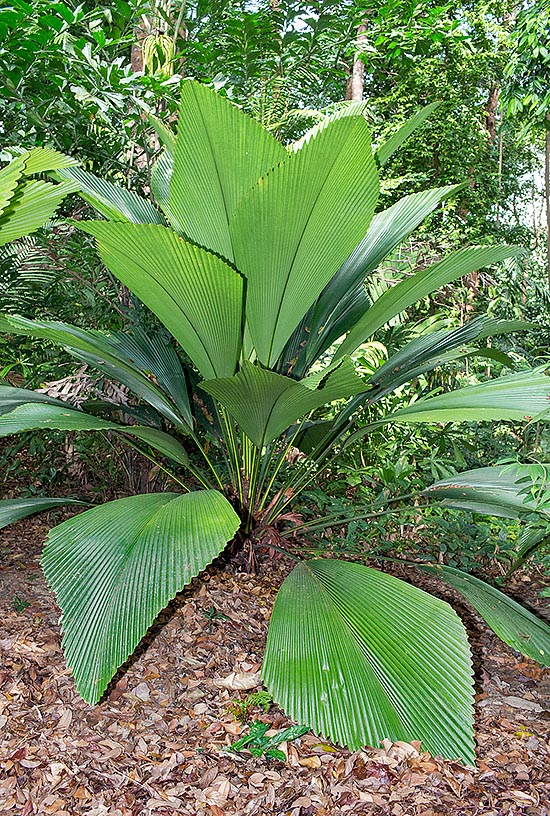Family : Arecaceae

Text © Pietro Puccio

English translation by Mario Beltramini

Rare in nature, Johannesteijsmannia altifrons is a monoecious species of south-east Asia with single creeping stem, subterranean or short, up to about 30 cm tall and of 15 cm of diameter © Giuseppe Mazza
The genus is honoured to the Dutch botanist Johannes Elias Teijsmann (1808-1882); the specific name is the combination of the Latin adjective “altus, a, um” = high and of the substantive = frond, foliage, with obvious reference.
Common names: joey palm, umbrella leaf palm (English); palmeira-diamante (Brazil); segalok, payung (Malaysia); bang soon (Thailand).
The Johannesteijsmannia altifrons (Rchb.f. & Zoll.) H.E.Moore (1961) is a monoecious species with single creeping stem, subterranean or short, up to about 30 cm tall and of 15 cm of diameter. The leaves, on a 1-2,5 m long petiole with margins provided of blackish teeth about 1 mm long and often with two yellow bands on the sides, are erect, simple, elongated-rhomboidal with pointed base and obtuse apex, 2,5-3,5 m long and 0,5-1,6 m broad in the median part, plicate and toothed on the upper margins, coriaceous, of intense green colour.
The inflorescences, ramified until the third order, 0,5-1 m long, generate between the leaves on a robust tomentose peduncle long 0,3-0,6 m, initially erect then curved, protected during the initial phase of development by 5-7 pale brown sheathed spathes, persistent, up to 20 cm long; numerous close hermaphroditic flowers, fleshy, of cream white colour, with 6 stamina. The fruits are globose, of about 4 cm of diameter, of brown colour covered by up to about 1 cm long pyramidal protuberances, containing one seed only.
It reproduces by seed, previously kept in water for two days, in aerated and draining organic loam maintained humid at the temperature of 26-28 °C, with germination times of 1-3 months.
One of the most ornamental palms due to the enormous undivided leaves and also the most cultivated of the genus in the tropical and subtropical climate regions, where temperatures of some degrees under the +10 °C are short lasting exceptions. It requires a slightly shaded to semi-shaded exposition, sheltered from the winds that would damage the big leaves, and soils rich of organic substance, slightly acidic to neutral, perfectly draining and constantly humid, and a high ambient temperature. Possible transplants must be done making sure to disturb as little as possible the rooting apparatus, particularly sensitive.
Young specimens can be cultivated in pot for the decoration of greenhouses, winter gardens and bright and spacious interiors, but not at the direct sun, in loams rich of humus with addition, per a 30%, of coarse siliceous sand, or agri perlite for a best drainage, maintained constantly humid; the lowest temperatures must be preferably over the 16 °C and high ambient humidity. Tle leaves are locally utilized for the cover and the walls of huts and makeshift shelters.
Rare in the wild, due to the progressive reduction of its habitat, it has been inserted into the Red List of the IUCN (International Union for Conservation of Nature) as “Vulnerable” (species at risk of extinction in nature).
Synonym: Teysmannia altifrons Rchb.f. & Zoll. (1858).
→ For general notions about ARECACEAE please click here.
